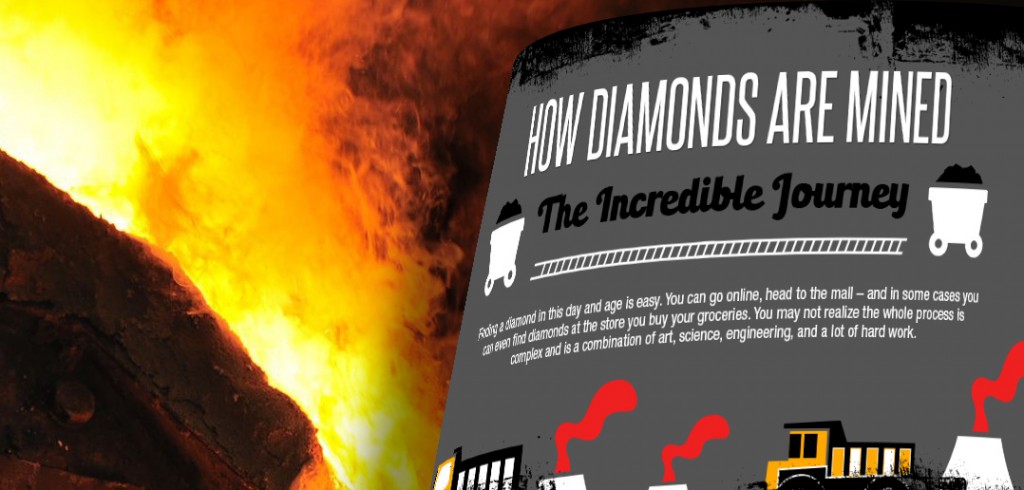There are many places you can buy diamonds from, but you may not realise the amount of work that goes into the production of these brilliant, sparkling stones. The whole process is a combination of art, science, engineerings and a lot of hard work.
Where do diamonds come from?
The process of diamond creation begins 100 miles underground where tremendous heat and pressure crystallize carbon into rough diamonds.
Diamonds reach the surface through a specific kind of volcanic eruption, called a kimberlite eruption.
The last kimberlite eruption is thought to have taken place more than 25 million years ago, and some scientists note that most occurred during the Cretaceous Period (146 million to about 65.5 million years ago).
Kimberlite pipes are created as magma flows through deep fractures in the Earth. The magma inside the kimberlite pipes acts like an elevator, pushing the diamonds and other rocks and minerals through the mantle and crust in just a few hours.
The magma eventually cooled inside these kimberlite pipes, leaving behind conical veins of kimberlite rock that contain diamonds.
How do we reach the kimberlite pipes?
To reach diamonds at the bottom of kimberlite pipes rocks are blasted and pit-mining begins.
Geologists sometimes use termites to find kimberlite pipes, since in building their mounds termites sometimes dig up rocks and minerals revealing that there could be diamonds below.
Heavy machinery, hydraulic shovels, and trucks are used to mine diamonds from the depths of kimberlite pipes.
Open pit vs. underground mining
If an area’s open pit mines are exhausted or impossible to build due to the inaccessibility of the desired resources, the mining process goes underground.
Open-pit mining is only used when diamonds are near the surface or covered by a thin layer of sand and gravel Underground mining methods are used when manual open pit methods for extraction become too costly.
These mines are not just big open holes. Instead, they consist of a series of ledges or benches, which are dug at angles to allow for extraction without causing structural weaknesses.
Diamond occurrence is measured in carats per ton of material. This value is known to decrease with depth into the kimberlite pipe.
Estimates of a mine’s life can be made by initial diamond occurrence values and exactly when (at what depth) it will become inefficient to keep practicing open mining techniques instead of underground mining methods.
The process involves essentially dissolving deeper into the kimberlite pipe using intricate underground tunnelling systems.
Horizontal mining vs. vertical mining
In horizontal mining a crawler uses flexible hoses on the ocean floor to bring diamonds to the surface.
In vertical mining a large-diameter drill allows for greater depth and brings diamond-bearing gravel to the surface. Diamonds are mined from depths of 90 – 14 meters.
Alluvial minig vs. pipe mining
The term, Alluvial Mining is based from the Latin word of “Alluvius” – which roughly translated means “to wash against”.
This provides a better understanding of the actual process of alluvial diamond mining which is done in riverbeds and beaches where diamonds have been washed out of their host rock and transported by erosion.
This method requires that walls be built to hold back the water and sand in the area rich with diamonds – or as the case is now, beaches are moved by machinery until the deposits of diamonds can be easily found, though there’s nothing easy about moving tons of earth.
As the desire and search for diamonds increased – people sought new ways to recover these gems which lead to the more widely known form of diamond extraction which led to pipe mining.
Pipe Mining is done where diamonds have been located in situ, having come from deep in the earth through natural volcanic fissures/tunnels or “pipes”. While the volcanic pipes are natural, the tunnels used to extract the diamonds are calculated and man made.
These types of diamond mines allow for more predictable retrieval than alluvial mining.
Instead of allowing diamonds to slowly creep their way along a volcanic pipe up to the surface of the earth to be swept away into a river or ocean bed – the diamonds are retrieved while they are closer to home.’
This type of diamond mine allows searchers to break up the earth near the volcanic pipe and transport it to the surface, where once again it is transported to a screening facility to really hunt and find diamonds outside of the actual mining area.
What changes are made?
The first step in processing diamonds is comminution i.e. breaking the ore by crushing and milling.
Once the ore has been crushed it is mixed with a “slurry made of finely ground ferrosilicon” of a particular density in a process called dense medium separation.
Because diamonds repel water and are drawn to grease, the crushed ore is passed over a grease belt that the diamonds then stick to.
How diamonds are categorised
Rough diamonds are sorted at DeBeer’s central selling organization (CSO for cutting, sawing, or for industrial use.
Diamonds are sorted in thousands of categories according to weight, color and clarity.
Though automation is used to sort diamonds, experts can categorize diamonds into 5,000 categories. Rough diamonds are sorted into three categories gem quality, industrial quality, and boart.
Diamonds are cut and sawed till the stone is smoothed. After the diamonds are “manufactured” they are ready to be sold to jewellery makers and diamond wholesalers.




